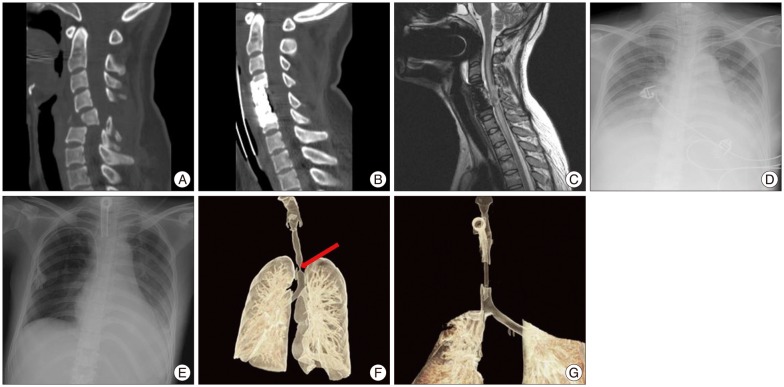J Korean Neurosurg Soc.
2013 Sep;54(3):220-224. 10.3340/jkns.2013.54.3.220.
The Effectiveness of Early Tracheostomy (within at least 10 Days) in Cervical Spinal Cord Injury Patients
- Affiliations
-
- 1Department of Neurosurgery, School of Medicine, Inje University, Busan Paik Hospital, Busan, Korea. shpaeng@empas.com
- KMID: 2190901
- DOI: http://doi.org/10.3340/jkns.2013.54.3.220
Abstract
OBJECTIVE
This study aimed to determine the optimal time for tracheostomy by evaluating the benefits and safety of early versus late tracheostomy in spinal cord injury (SCI) patients.
METHODS
We retrospectively reviewed a total of 254 patients with spinal cord injury. Of them, we selected 21 spinal cord injury patients who required tracheostomy due to long-term mechanical ventilation and analyzed their medical records. The patients were categorized into two groups. Early tracheostomy was performed day 1-10 from intubation in 10 patients and the late tracheostomy was performed after day 10 in 11 cases. We also evaluated the duration of mechanical ventilation, stay in the ICU and complications related to tracheostomy, the injury level of and clinical severity. All data was analyzed using SPSS 18.0/WIN.
RESULTS
The early tracheostomy offered clear advantages for shortening the total ICU stay (20.8 day vs. 38.0 day, p=0.010). There was also statistically significant reduction in the total length of time on mechanical ventilation (5.2 day vs. 29.2 day, p=0.009). However, the reductions in the incidence of pneumonia (40% vs. 82%) and the length of ICU stay post to tracheostomy (6 day vs. 15 day) were found to be statistically not significant. There were also no statistically significant differences in the injury level and clinical severity between the groups.
CONCLUSION
We concluded that the early tracheostomy (at least 10 days) is beneficial for SCI patients who are likely to require prolonged mechanical ventilation.
Keyword
MeSH Terms
Figure
Reference
-
1. Ball PA. Critical care of spinal cord injury. Spine (Phila Pa 1976). 2001; 26(24 Suppl):S27–S30. PMID: 11805605.
Article2. Biering-Sørensen M, Biering-Sørensen F. Tracheostomy in spinal cord injured : frequency and follow up. Paraplegia. 1992; 30:656–660. PMID: 1408343.3. Bouderka MA, Fakhir B, Bouaggad A, Hmamouchi B, Hamoudi D, Harti A. Early tracheostomy versus prolonged endotracheal intubation in severe head injury. J Trauma. 2004; 57:251–254. PMID: 15345969.
Article4. Bryce DP, Briant TD, Pearson FG. Laryngeal and tracheal complications of intubation. Ann Otol Rhinol Laryngol. 1968; 77:442–461. PMID: 5667939.5. Claxton AR, Wong DT, Chung F, Fehlings MG. Predictors of hospital mortality and mechanical ventilation in patients with cervical spinal cord injury. Can J Anaesth. 1998; 45:144–149. PMID: 9512849.
Article6. Davis K Jr, Campbell RS, Johannigman JA, Valente JF, Branson RD. Changes in respiratory mechanics after tracheostomy. Arch Surg. 1999; 134:59–62. PMID: 9927132.
Article7. Diehl JL, El Atrous S, Touchard D, Lemaire F, Brochard L. Changes in the work of breathing induced by tracheotomy in ventilator-dependent patients. Am J Respir Crit Care Med. 1999; 159:383–388. PMID: 9927347.
Article8. Fischler L, Erhart S, Kleger GR, Frutiger A. Prevalence of tracheostomy in ICU patients. A nation-wide survey in Switzerland. Intensive Care Med. 2000; 26:1428–1433. PMID: 11126252.
Article9. Goldenberg D, Ari EG, Golz A, Danino J, Netzer A, Joachims HZ. Tracheotomy complications : a retrospective study of 1130 cases. Otolaryngol Head Neck Surg. 2000; 123:495–500. PMID: 11020193.
Article10. Griffiths J, Barber VS, Morgan L, Young JD. Systematic review and meta-analysis of studies of the timing of tracheostomy in adult patients undergoing artificial ventilation. BMJ. 2005; 330:1243. PMID: 15901643.
Article11. Harrop JS, Sharan AD, Scheid EH Jr, Vaccaro AR, Przybylski GJ. Tracheostomy placement in patients with complete cervical spinal cord injuries : American Spinal Injury Association Grade A. J Neurosurg. 2004; 100(1 Suppl Spine):20–23. PMID: 14748569.
Article12. Kluger Y, Paul DB, Lucke J, Cox P, Colella JJ, Townsend RN, et al. Early tracheostomy in trauma patients. Eur J Emerg Med. 1996; 3:95–101. PMID: 9028753.
Article13. Mansel JK, Norman JR. Respiratory complications and management of spinal cord injuries. Chest. 1990; 97:1446–1452. PMID: 2189697.
Article14. Möller MG, Slaikeu JD, Bonelli P, Davis AT, Hoogeboom JE, Bonnell BW. Early tracheostomy versus late tracheostomy in the surgical intensive care unit. Am J Surg. 2005; 189:293–296. PMID: 15792753.
Article15. National Spinal Cord Injury Statistical Center. 2009. Accessed July 14. Available at: http://www.spinalcord.uab.edu.16. O'Keeffe T, Goldman RK, Mayberry JC, Rehm CG, Hart RA. Tracheostomy after anterior cervical spine fixation. J Trauma. 2004; 57:855–860. PMID: 15514542.17. Parent A. Carpenter's Human Neuroanatomy. ed 9. Baltimore: Lippincott Williams and Wilkins;1995. p. 273.18. Plummer AL, Gracey DR. Consensus conference on artificial airways in patients receiving mechanical ventilation. Chest. 1989; 96:178–180. PMID: 2500308.
Article19. Rodriguez JL, Steinberg SM, Luchetti FA, Gibbons KJ, Taheri PA, Flint LM. Early tracheostomy for primary airway management in the surgical critical care setting. Surgery. 1990; 108:655–659. PMID: 2218876.
Article20. Romero J, Vari A, Gambarrutta C, Oliviero A. Tracheostomy timing in traumatic spinal cord injury. Eur Spine J. 2009; 18:1452–1457. PMID: 19655178.
Article21. Velmahos GC, Toutouzas K, Chan L, Tillou A, Rhee P, Murray J, et al. Intubation after cervical spinal cord injury : to be done selectively or routinely? Am Surg. 2003; 69:891–894. PMID: 14570369.
- Full Text Links
- Actions
-
Cited
- CITED
-
- Close
- Share
- Similar articles
-
- Impact of Early Tracheostomy on Hospital-Acquired Pneumonia and Infection of Anterior Cervical Fusion Site in Patients with Acute Cervical Cord Injury
- The Need for Early Tracheostomy in Patients with Traumatic Cervical Cord Injury
- Predictive Values of Magnetic Resonance Imaging Features for Tracheostomy in Traumatic Cervical Spinal Cord Injury
- Acute Spinal Cord Injury after Cervical Nerve Root Block
- A Nomogram Model for Prediction of Tracheostomy in Patients With Traumatic Cervical Spinal Cord Injury


